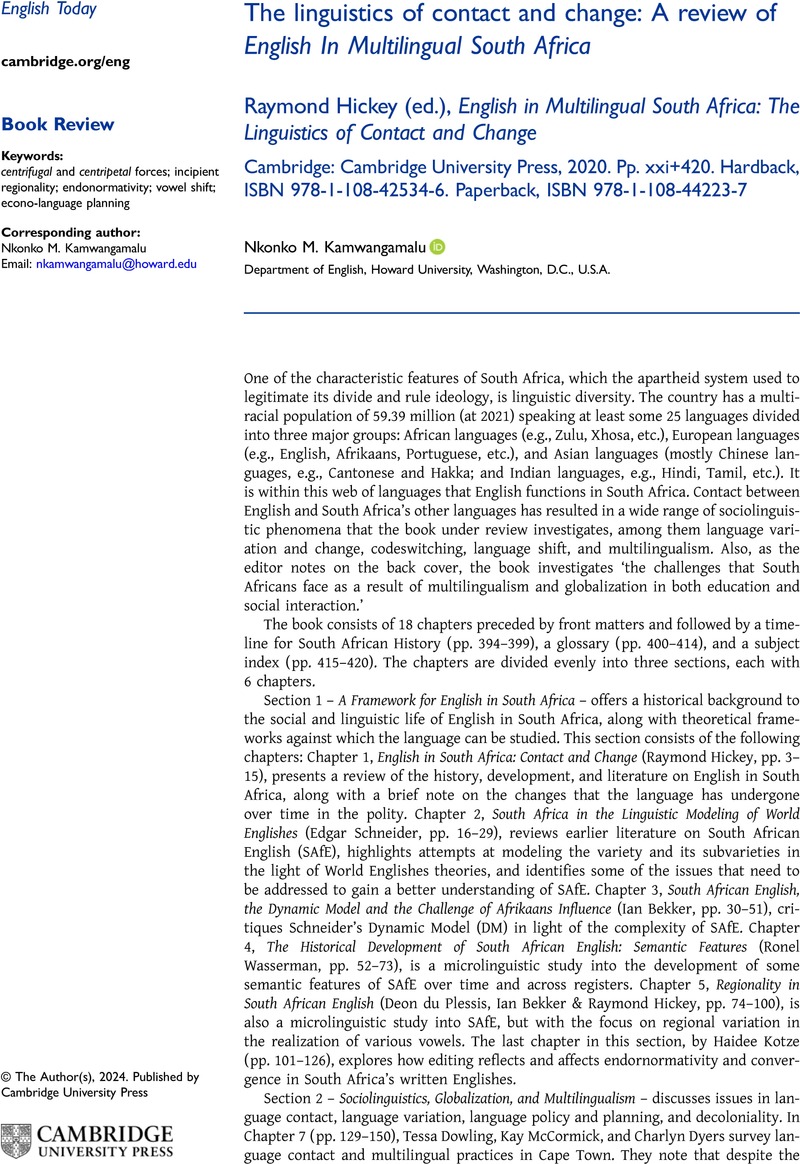No CrossRef data available.
Article contents
The linguistics of contact and change: A review of English In Multilingual South Africa - Raymond Hickey (ed.), English in Multilingual South Africa: The Linguistics of Contact and Change Cambridge: Cambridge University Press, 2020. Pp. xxi+420. Hardback, ISBN 978-1-108-42534-6. Paperback, ISBN 978-1-108-44223-7
Review products
Raymond Hickey (ed.), English in Multilingual South Africa: The Linguistics of Contact and Change Cambridge: Cambridge University Press, 2020. Pp. xxi+420. Hardback, ISBN 978-1-108-42534-6. Paperback, ISBN 978-1-108-44223-7
Published online by Cambridge University Press: 18 September 2024
Abstract
An abstract is not available for this content so a preview has been provided. Please use the Get access link above for information on how to access this content.

Keywords
- Type
- Book Review
- Information
- Copyright
- Copyright © The Author(s), 2024. Published by Cambridge University Press
References
Bekker, I. 2013. “The Formation of South African English.” English Today 29 (1): 3–9.CrossRefGoogle Scholar
Blaut, J. M. 1993. The Colonizer's Model of the World: Geographical Diffusionism and Eurocentric History. New York: Guilford Press.Google Scholar
Djite, P. 2008. The Sociolinguistics of Development in Africa. Clevedon: Multilingual Matters.CrossRefGoogle Scholar
Kamwangamalu, N. M. (ed.) 2002. “English in South Africa. A Special Issue.” World Englishes 21 (1). Oxford: Blackwell.CrossRefGoogle Scholar
Kamwangamalu, N. M. 2003. “When 2 + 9 = 1: English and the Politics of Language Planning in a Multilingual Society: South Africa.” In The Politics of English as a World Language, edited by Mair, C., 235–246. New York, NY: Rodopi B.V.CrossRefGoogle Scholar
Kamwangamalu, N. M. 2016. Language Policy and Economics: The Language Question in Africa. New York: Palgrave Macmillan.Google Scholar
Lass, R. 1995. “South African English.” In Language and Social History: Studies in South African Sociolinguistics, edited by Mesthrie, R., 68–88. Cape Town: David Philip.Google Scholar
Mesthrie, R. 2010. “Socio-Phonetics and Social Change: Deracialization of the GOOSE Vowel in South African English.” Journal of Sociolinguistics 14 (1): 3–33.CrossRefGoogle Scholar
Mesthrie, R, 2017. “Class, Gender, and Substrate Erasure in Sociolinguistic Change: A Sociophonetic Study of Schwa in Deracializing South African English.” Language 93 (2): 314–346.CrossRefGoogle Scholar
Naidoo, J. 2012. “The Hegemonic Position of English as a Medium of Instruction at Primary School Level in Kwazulu-Natal, and its Impact on Parents' Preferences of Schooling for their Children.” PhD diss., KwaZulu-Natal, South Africa: Durban University of Technology.Google Scholar
Silva, P. 1998. “South African English: Oppressor or Liberator.”The Major Varieties of English, Papers from MAVEN 97. ACTA WEXIONENSIA Humaniora/Humanities 1: 69–78.Google Scholar
Smit, U. 1998. “South African English Lexemes for South Africans – a Case in Point for a Developing Multicultural Standard of English.” The Major Varieties of English. Papers from MAVEN 97. ACTA WEXIONENSIA Humaniora/Humanities 1: 79–92Google Scholar
Van der Walt, U., and Van den Berg, B. 2014. “English Medium of Instruction: A Situation Analysis.” South African Journal of Education 27 (1): 69–82.Google Scholar



